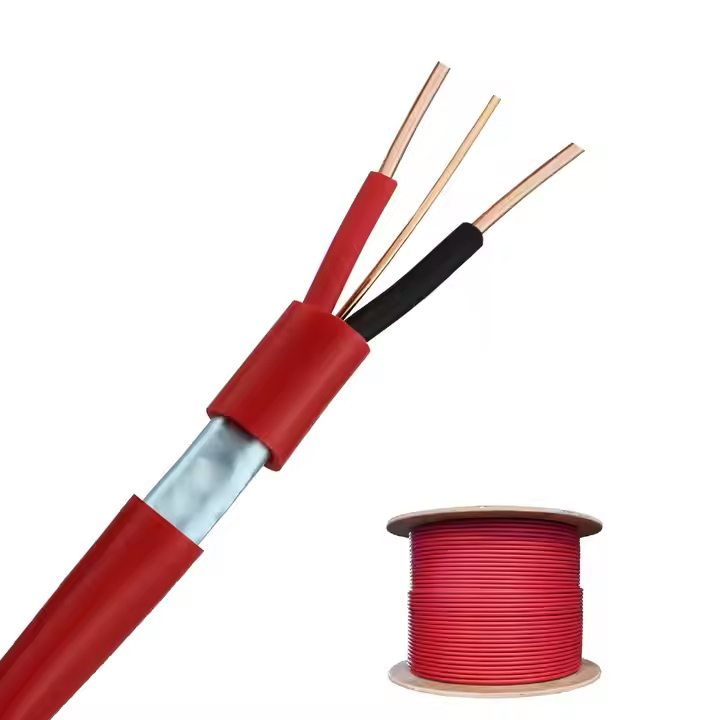
Product Overview
This Fire Alarm Flat Cable, specifically designed as a 2X2.5mm² +E Flat Twin and Earth configuration, is engineered to provide critical circuit integrity and reliable signal transmission within fire detection and alarm systems. Certified to the rigorous BS 5839-1 standard for fire alarm cables in the UK, it offers enhanced fire performance, low smoke emission, and halogen-free properties essential for life safety applications and safe evacuation routes. Its compact flat profile simplifies installation in conduits, trunking, and surface mounting.
Key Technical Specifications & Standards Compliance
-
Standard: Compliant with BS 5839-1:2017 (Fire detection and fire alarm systems for buildings) & BS EN 50525-2-11 (Electric cables - Low voltage energy cables of rated voltages up to and including 450/750 V).
-
Conductor:
-
Material: High Conductivity Plain Annealed Solid Copper
-
Number & Size: 2 Solid Cores
-
Cross-Sectional Area: 2.5 mm² per core
-
-
Earth Conductor (CPC):
-
Material: High Conductivity Plain Annealed Solid Copper
-
Cross-Sectional Area: 1.5 mm² (Standard for 2.5mm² T&E)
-
-
Insulation:
-
Material: Flame Retardant, Low Smoke Zero Halogen (LSZH) Compound
-
Colour: Core 1: Red, Core 2: Blue (Standard fire alarm colours), Earth: Green/Yellow Stripe
-
Thickness: Conforms to BS EN 50525 requirements.
-
-
Sheath (Outer Jacket):
-
Material: Flame Retardant, Low Smoke Zero Halogen (LSZH) Compound
-
Colour: Typically Red (Standard for fire alarm circuits) or White.
-
Thickness: Conforms to BS EN 50525 requirements.
-
-
Construction: Flat Parallel Twin & Earth (Separate insulated conductors laid parallel with bare earth conductor, over-sheathed).
-
Voltage Rating: 300/500V
-
Operating Temperature Range: -20°C to +70°C (Fixed Installation)
-
Fire Performance:
-
Circuit Integrity (CI): Designed to maintain functionality under fire conditions for a specified period (Duration depends on system design requirements and installation method - consult BS 5839-1).
-
Flame Propagation: Passes IEC 60332-1-2 (Single vertical flame test) or higher as per BS 5839-1 requirements.
-
Smoke Emission: Very Low (LSZH).
-
Acidity/Gas Emission: Halogen-Free (Reduced toxic/corrosive fumes).
-
-
Approvals: Independently tested and certified by UKAS-accredited bodies to BS 5839-1.
Product Structure Description
-
Conductors: Two solid circular copper conductors, each with a nominal cross-sectional area of 2.5 mm², providing excellent conductivity and mechanical stability.
-
Earth Conductor (CPC): One solid circular copper conductor, nominal cross-sectional area 1.5 mm², bare or sometimes tinned (check specific product datasheet), laid parallel between the live cores.
-
Core Insulation: Each current-carrying conductor (Lives) is individually insulated with a tightly extruded layer of coloured LSZH compound (Red & Blue). The earth conductor is bare or insulated (Green/Yellow) depending on construction (Flat T&E typically has bare earth).
-
Outer Sheath (Jacket): The insulated cores and bare earth conductor are collectively enclosed within a durable, extruded outer sheath of LSZH compound. This sheath is formed into a flat, oval profile, minimizing overall installation space. The standard colour is red for easy identification as a fire alarm circuit cable.
Material Characteristics & Advantages
-
Solid Copper Conductors: Offer superior electrical conductivity, ease of termination, and mechanical strength suitable for fixed installations.
-
LSZH Insulation & Sheath:
-
Flame Retardant: Significantly resists ignition and flame spread.
-
Low Smoke: Minimizes obscuration during a fire, aiding visibility for evacuation and firefighting.
-
Zero Halogen: Eliminates the production of corrosive/toxic halogenated gases (like HCl) when exposed to fire, protecting sensitive equipment and personnel.
-
-
Flat Profile: Enables efficient space utilization in conduits, trunking, and cable trays, simplifies clipping/routing, and allows for neat surface installations.
-
Colour Coding: Standard red/blue live cores and green/yellow earth ensure clear identification and correct installation according to wiring regulations.
Primary Application Scenarios
This cable is mandatory for fixed wiring within fire detection and fire alarm systems in buildings, specifically designed to meet the enhanced safety requirements of:
-
Fire Alarm Control Panel (FACP) Circuits: Connecting panels to detectors, call points, sounders, and interface modules.
-
Detection Circuits: Wiring for smoke detectors, heat detectors, multi-sensors, and beam detectors.
-
Alarm Device Circuits: Wiring for sounders (bells, sirens), visual alarms (beacons), and voice alarm systems.
-
Monitoring Circuits: Connections for input/output modules monitoring other safety systems.
-
Emergency Lighting Circuits (where specified): In systems requiring fire-rated cabling for emergency luminaires on escape routes (verify specific system design requirements).
-
Escape Route Signage Circuits (where specified): Powering illuminated exit signs requiring fire-resistant cabling.
Engineering Selection Guidance
-
Compliance is Critical: Always specify cable explicitly certified to BS 5839-1 for fire alarm system wiring in the UK. This is non-negotiable for life safety systems.
-
Conductor Size (2.5mm²): Suitable for standard power requirements of fire alarm devices (detectors, sounders, modules) over typical circuit lengths. Verify voltage drop calculations for longer runs or higher current devices (e.g., powerful sounders or beacon clusters).
-
Solid Core: Ideal for fixed installations terminated into screw terminals or clamp connectors (e.g., in detectors, call points, panels). Not suitable for applications requiring frequent flexing.
-
LSZH Requirement: Essential for installations in confined spaces, public areas, escape routes, and areas with sensitive electronic equipment to minimize smoke and toxic gas hazards during fire.
-
Flat Design Advantage: Choose this profile where space constraints exist in conduits or trunking, or where a low-profile surface installation is preferred.
-
Installation: Must be installed in accordance with BS 5839-1, BS 7671 (IET Wiring Regulations), and manufacturer's guidelines. Pay particular attention to separation from non-fire alarm cables, support, and protection against mechanical damage. Circuit integrity performance is dependent on correct installation methods (e.g., use of fire-rated supports, fixings, and containment where required).
